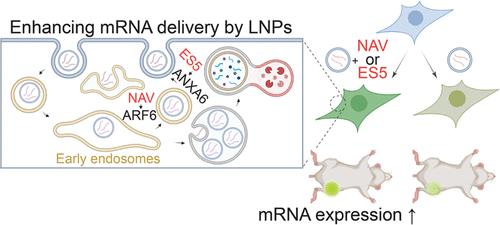当前位置:
X-MOL 学术
›
Nano Lett.
›
论文详情
Our official English website, www.x-mol.net, welcomes your feedback! (Note: you will need to create a separate account there.)
Targeting Recycling Endosomes to Potentiate mRNA Lipid Nanoparticles
Nano Letters ( IF 10.8 ) Pub Date : 2024-04-19 , DOI: 10.1021/acs.nanolett.3c04415 Jeehae Shin 1, 2 , Cameron J. Douglas 3, 4 , Shanwen Zhang 2 , Ciaran P. Seath 3 , Huan Bao 1, 2
Nano Letters ( IF 10.8 ) Pub Date : 2024-04-19 , DOI: 10.1021/acs.nanolett.3c04415 Jeehae Shin 1, 2 , Cameron J. Douglas 3, 4 , Shanwen Zhang 2 , Ciaran P. Seath 3 , Huan Bao 1, 2
Affiliation

|
mRNA lipid nanoparticles (LNPs) have emerged as powerful modalities for gene therapies to control cancer and infectious and immune diseases. Despite the escalating interest in mRNA-LNPs over the past few decades, endosomal entrapment of delivered mRNAs vastly impedes therapeutic developments. In addition, the molecular mechanism of LNP-mediated mRNA delivery is poorly understood to guide further improvement through rational design. To tackle these challenges, we characterized LNP-mediated mRNA delivery using a library of small molecules targeting endosomal trafficking. We found that the expression of delivered mRNAs is greatly enhanced via inhibition of endocytic recycling in cells and in live mice. One of the most potent small molecules, endosidine 5 (ES5), interferes with recycling endosomes through Annexin A6, thereby promoting the release and expression of mRNA into the cytoplasm. Together, these findings suggest that targeting endosomal trafficking with small molecules is a viable strategy to potentiate the efficacy of mRNA-LNPs.
中文翻译:

靶向回收内体以增强 mRNA 脂质纳米颗粒
mRNA 脂质纳米颗粒 (LNP) 已成为控制癌症、传染病和免疫疾病的基因治疗的强大方式。尽管过去几十年人们对 mRNA-LNP 的兴趣不断增加,但递送的 mRNA 的内体包埋极大地阻碍了治疗的发展。此外,LNP 介导的 mRNA 传递的分子机制知之甚少,无法通过合理设计指导进一步改进。为了应对这些挑战,我们使用针对内体运输的小分子库来表征 LNP 介导的 mRNA 递送。我们发现,通过抑制细胞和活小鼠的内吞循环,递送的 mRNA 的表达大大增强。内苷 5 (ES5) 是最有效的小分子之一,它通过膜联蛋白 A6 干扰核内体的再循环,从而促进 mRNA 释放并表达到细胞质中。总之,这些发现表明,用小分子靶向内体运输是增强 mRNA-LNP 功效的可行策略。
更新日期:2024-04-19
中文翻译:

靶向回收内体以增强 mRNA 脂质纳米颗粒
mRNA 脂质纳米颗粒 (LNP) 已成为控制癌症、传染病和免疫疾病的基因治疗的强大方式。尽管过去几十年人们对 mRNA-LNP 的兴趣不断增加,但递送的 mRNA 的内体包埋极大地阻碍了治疗的发展。此外,LNP 介导的 mRNA 传递的分子机制知之甚少,无法通过合理设计指导进一步改进。为了应对这些挑战,我们使用针对内体运输的小分子库来表征 LNP 介导的 mRNA 递送。我们发现,通过抑制细胞和活小鼠的内吞循环,递送的 mRNA 的表达大大增强。内苷 5 (ES5) 是最有效的小分子之一,它通过膜联蛋白 A6 干扰核内体的再循环,从而促进 mRNA 释放并表达到细胞质中。总之,这些发现表明,用小分子靶向内体运输是增强 mRNA-LNP 功效的可行策略。



























 京公网安备 11010802027423号
京公网安备 11010802027423号